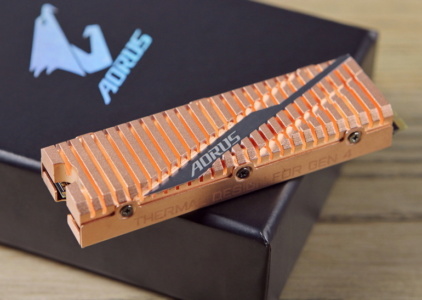
With the advent of motherboards based on the AMD X570 chipset that supports the PCI Express 4.0 bus, high-speed storage manufacturers have the opportunity to offer faster SSDs in the popular M.2 NVMe format. Today we have on review one of the first models available on the market that supports the new standard bus – AORUS NVMe SSD PCIe4 2 TB. Let’s check if PCI-E 4.0 can really be useful for solid-state drives of the usual standard.
Message from the editor: Our defenders from the 115th brigade, which is now fighting in the east, need a pickup truck . Details for transferring funds to a monobank card – Polyanskaya Karine Sergeevna, card number 5375414101372265. We ask you to take part in the fundraising.
Glory to Ukraine!
from 9 489 UAH
Offers: 17
AORUS NVME Gen4 SSD Series
The new line includes three models with capacities of 500 GB, 1 TB and 2 TB. Quite viable options. Smaller devices are simply not needed for drives of this class, and larger ones will be unreasonably expensive. For SSD, in fact, the only actual controller that supports the PCI Express 4.0 bus is used – Phison PS5016-E16 . This chip is actually a modified version of Phison E12, which is often used for mid-range drives. The controller has two cores and the ability to use an 8-channel 3D TLC / QLC flash memory connection scheme and additional caching with a buffer on DDR4 chips.
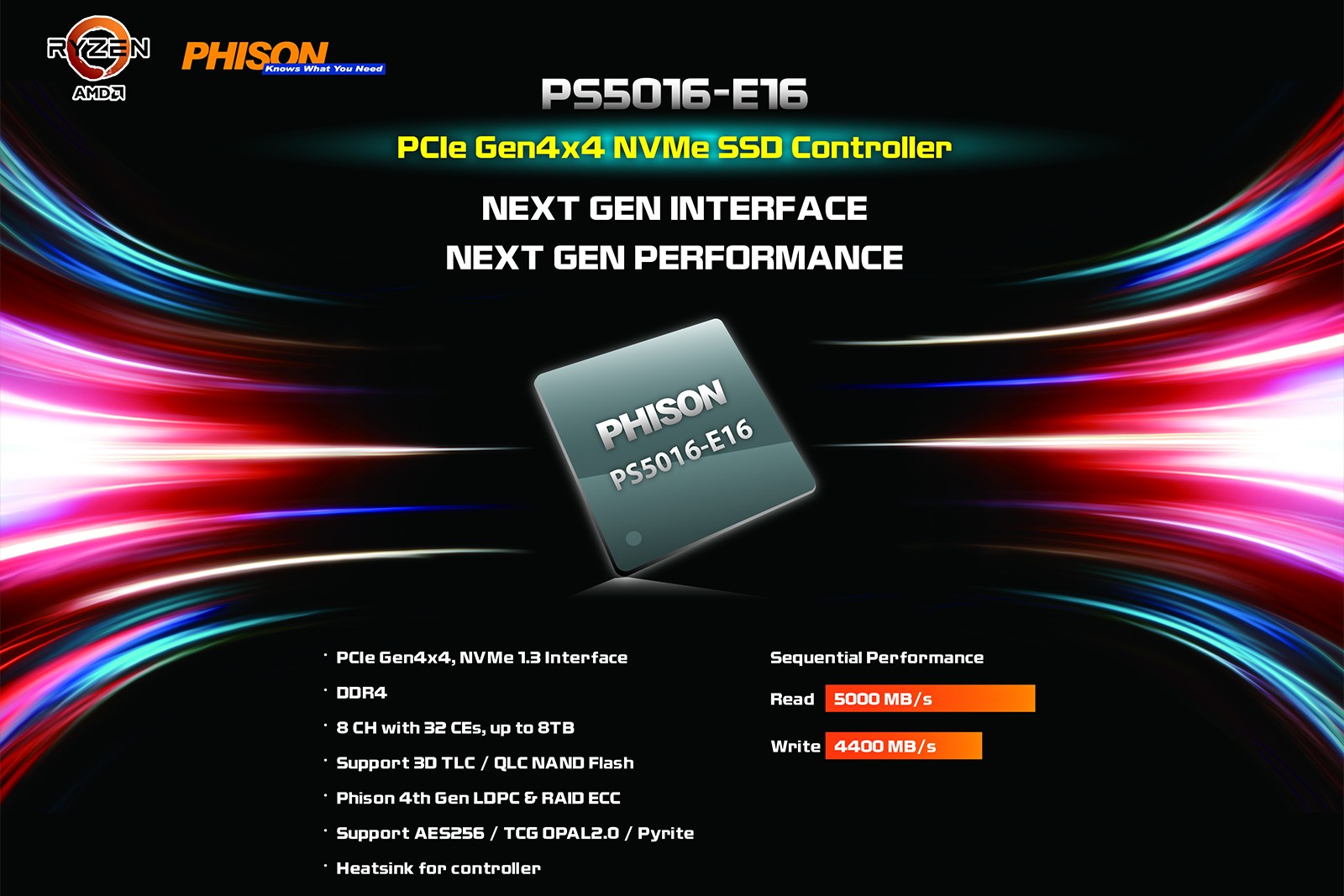
Despite moderate computing performance, PCI-E 4.0 support allows the manufacturer to claim higher data transfer rates. In particular, the controller can provide up to 5000 MB / s for linear reading and up to 4400 MB / s for writing data.
| 500 GB | 1 TB | 2 TB | |
| Model | GP-ASM2NE6500GTTD | GP-ASM2NE6100TTTD | GP-ASM2NE6200TTTD |
| Controller | Phison PS5016-E16 | ||
| Flash memory | 96-layer 3D TLC (Toshiba BiSC4) | ||
| Form factor, interface | M.2 2280, PCI Express 4.0 x4, NVMe 1.3 | ||
| Sequential reading | 5000 MB/s | 5000 MB/s | 5000 MB/s |
| Sequential write | 2500 MB/s | 4400 MB/s | 4400 MB/s |
| Random reading of 4K blocks | 750,000 IOPS | 750,000 IOPS | 400,000 IOPS |
| Random 4K block recording | 700,000 IOPS | 700,000 IOPS | 550,000 IOPS |
| Guaranteed Recording Capacity (TBW) | 850 TB | 1800 TB | 3600 TB |
| Power consumption, (read/write, average) | 5.9/4.5W | 6.6/6.4W | 6.5/6.6W |
| Manufacturer’s warranty period | 5 years | ||
AORUS NVME Gen4 SSD uses 96-layer 3D TLC Toshiba BiSC4 flash memory chips with an additional DDR4 cache buffer, the amount of which depends on the capacity of the SSD. If we talk not about the theoretical capabilities of the controller, but about the declared performance of specific devices based on it, then for models with a capacity of 1 TB and 2 TB, the manufacturer promises transfers at the level of 5000/4400 MB / s for read / write, while for a 500 GB SSD it’s 5000/2500 MB/s.
Support for the PCI Express 4.0 bus allows you to go beyond the theoretical bandwidth limits of the M.2 PCI-E 3.0 x4 port – ~ 4000 MB / s. The new standard interface doubles this value. But, as we can see, the controller does not yet allow using the full potential of the new standard bus.
Peak drive I/O performance is 750,000/700,000 IOPS for older models, and 400,000/550,000 IOPS for the 500 GB version.

AORUS NVME Gen4 SSD claims very high guaranteed data write volumes for its class. The 500 GB model received TBW (Total Bytes Written) at 850 TB, 1 TB – 1800 TB, and the older 2 TB version – 3600 TB. Such values are uncharacteristic even for consumer drives based on two-bit cell chips (MLC), so it is gratifying to see such declarations for 3D TLC. A 5-year manufacturer’s warranty further reinforces the manufacturer’s confidence in the high write resource of 96-layer Toshiba BiSC4 chips.
AORUS NVME Gen4 SSD 2TB (GP-ASM2NE6200TTTD)
The top model of the line with a capacity of 2 TB came to us for testing. The drive is offered in a large box.

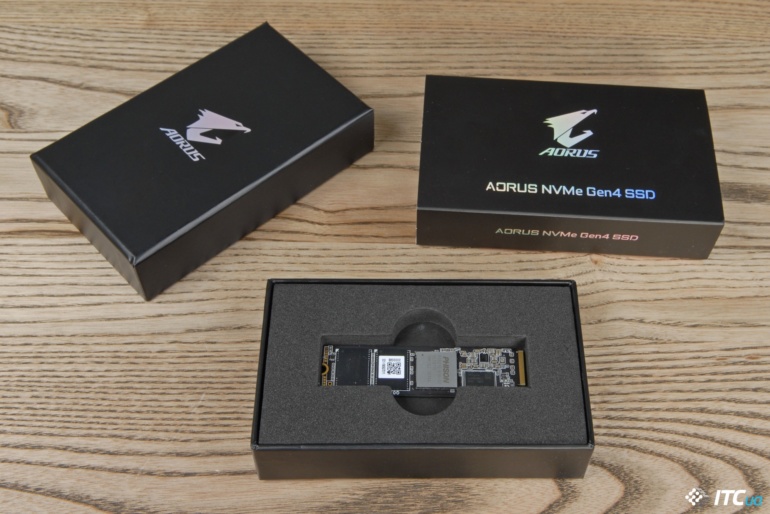
The device comes with a quick start guide and additional heatsink blocks.
The AORUS NVME Gen4 SSD 2GB features the familiar M.2 2280 M-key form factor of PCI-E drives. The SSD assumes a two-sided layout.
On the front surface of the PCB there is a Phison PS5016-E16 controller with a nickel-plated copper plate that acts as a miniature heat sink. Nearby are two flash memory chips with the designation TABHG65AWV. One of the DDR4 cache buffer chips from SK hynix is also located here.
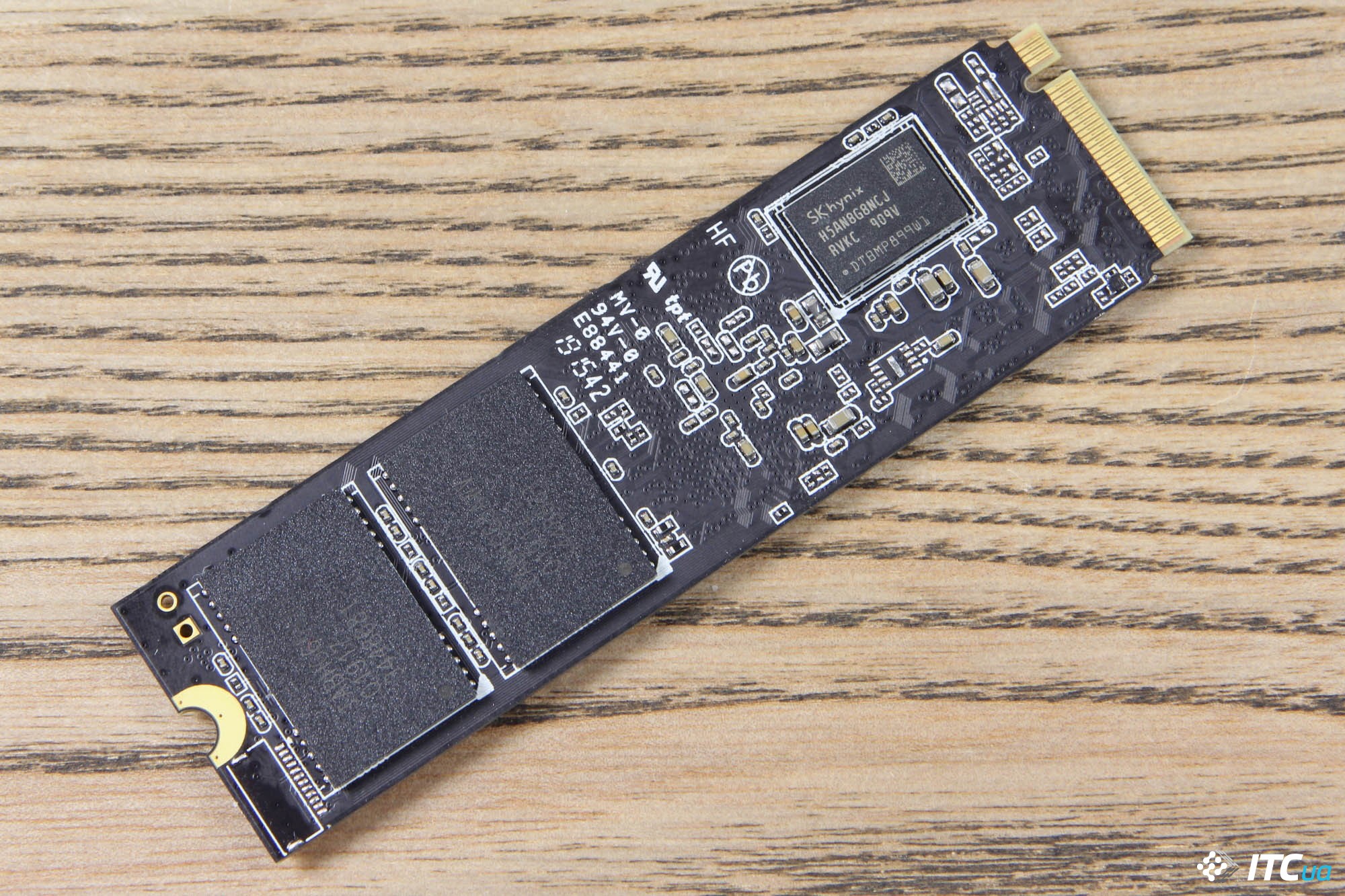
On the reverse side are two more flash memory chips of 500 GB each and a 1 GB DDR4-2666 chip.
It should be noted that the Taiwanese company Phison offers drive manufacturers not only a controller, but a ready-made platform. For this reason, SSDs with PCI-E 4.0 support based on the Phison PS5016-E16 will have an identical layout and very close specifications. The differences will be mainly in the design of cooling systems, software configuration and possibly cost if someone wants to play for a fall.
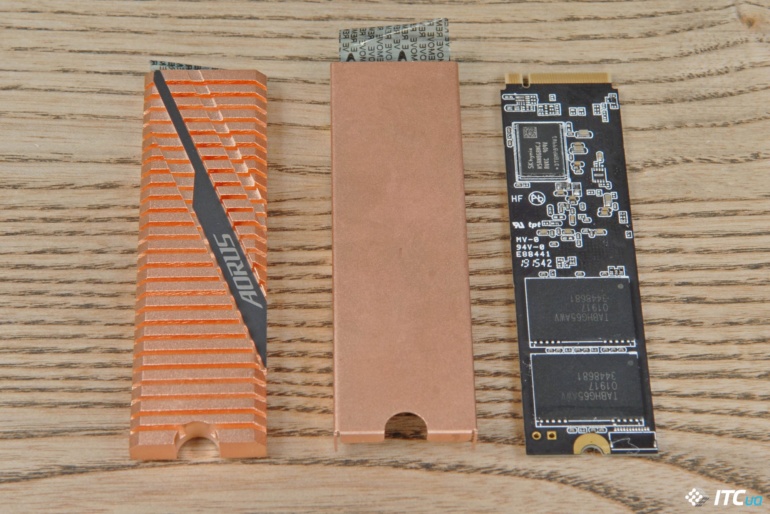
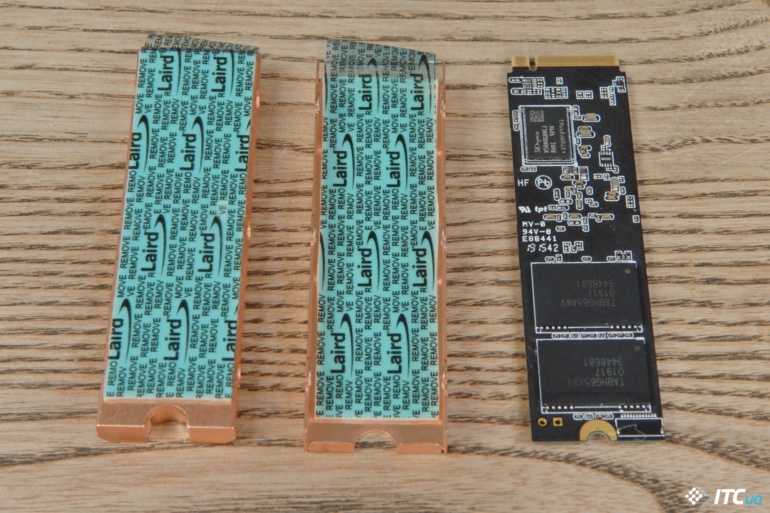
In the case of the AORUS NVME Gen4 SSD, a massive heatsink block made of copper is offered for the drive. The cooler made of such material has a better thermal conductivity than aluminum.
The radiator has a composite structure fastened with six screws. The element covering the back side of the printed circuit board is a thin plate, rather used for the visual integrity of the device.

But the main block is a fairly massive copper bar with a complex profile shape that allows you to capture air currents. Dressed in copper armor, the drive becomes very weighty – 95 grams. Given the dimensions of the device, such a mass is felt more clearly. We can assume that this is literally the heaviest consumer class SSD.
It is obvious that a radiator of such a mass is one of the ways to give a certain status to the device and additionally attract attention.
To manage or rather even basic monitoring of the drive, a proprietary SSD Tool Box utility is offered. Here you can evaluate the general condition of the SSD, the current temperature, as well as SMART indicators. There is the possibility of a complete cleaning of the device. At the same time, the Optimization section in our case turned out to be unavailable for some reason. In general, an indication of the total amount of recorded data would also be useful here, as well as the ability to update the firmware. During the launch of the program, the corresponding item appears, but it disappears after the drive is identified. We assume that the utility automatically checks the current firmware version, and if a new microcode for a specific SSD model is not available on the server, this option is automatically deactivated in the interface.
Performance
For our drive experiments, we used an AMD desktop platform with a Ryzen 7 3700X processor and an AMD X570-based GIGABYTE X570 AORUS MASTER motherboard. At the moment, this is the only mass-produced chipset that supports the PCI Express 4.0 bus, and, accordingly, allows you to determine the potential of new SSDs.
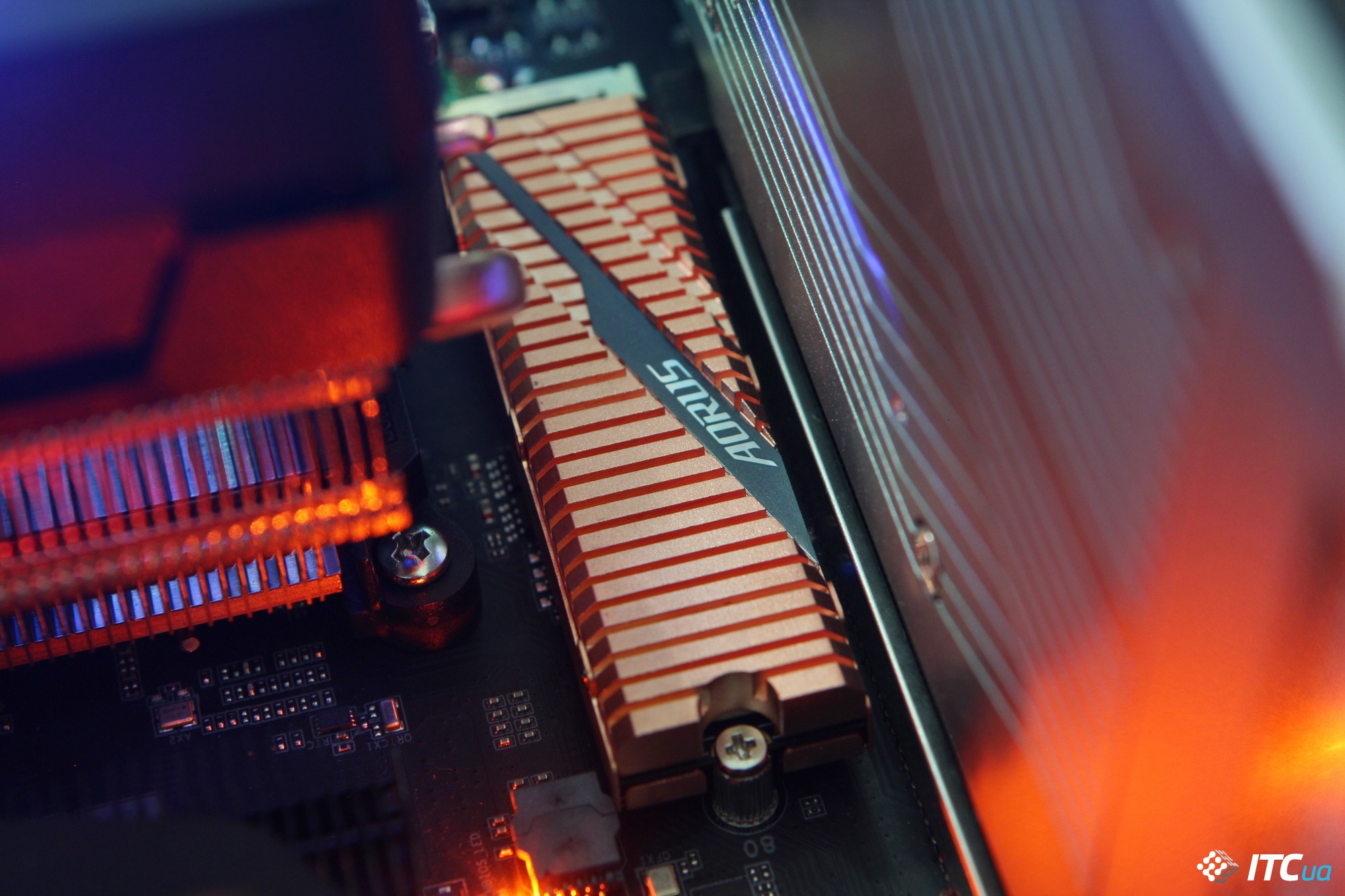
More recently, next-generation Ryzen Threadripper chips and AMD TRX40-based motherboards have also been introduced, which also have PCI Express 4.0 support.
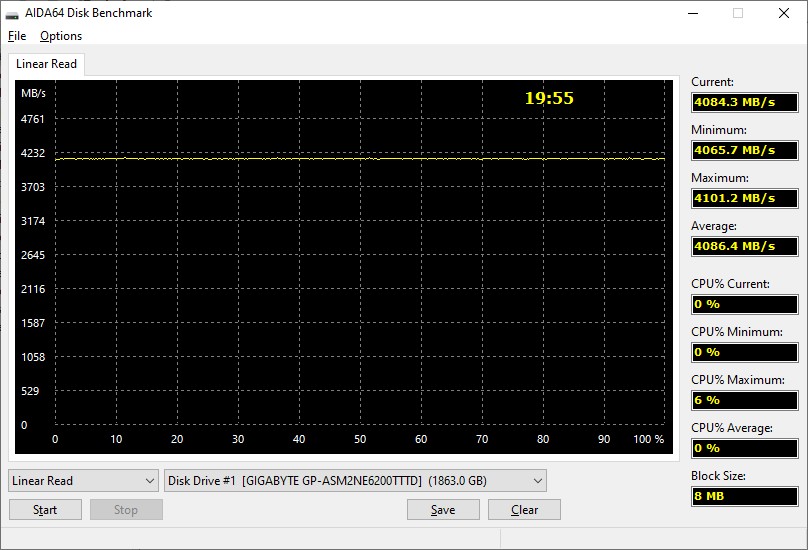
We started our practical tests by measuring the speed of linear transfers in the AIDA64 application. We fix sequential reading indicators at the level of 4100 MB / s.
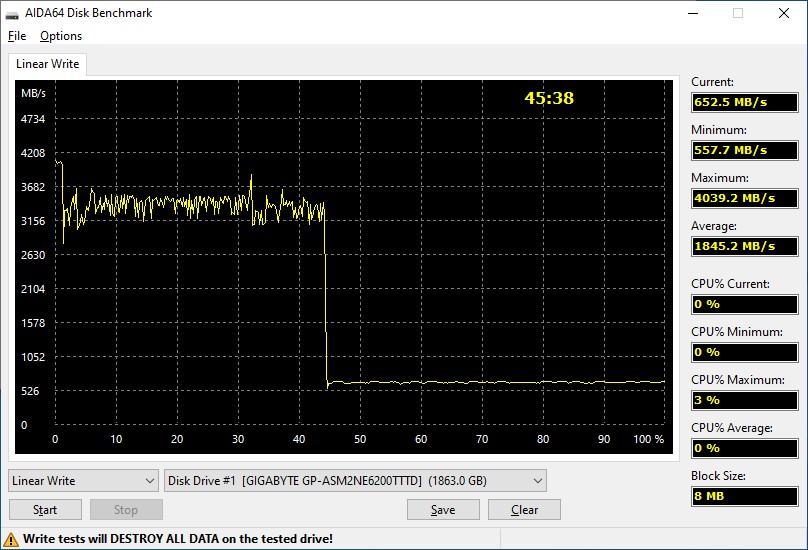
The situation with the record is curious. More than a third of the total volume of the data drive is stored at a speed of about 3500 MB / s. In the future, the speed decreases to ~550-570 MB / s – these are the real possibilities of 3D TLC flash memory in the configuration used. As you can see, unlike the Phison E12, the new controller can use dynamic SLC caching, and the volume of a conditionally “one-bit” buffer is limited only by the available free space on the SSD. In the case of the 2 TB model, over 600 GB of data can be written to a blank SSD at a high pace. Only after that the write speed decreases. I must say that the drop in speed is noticeable, but in realistic tasks the SLC buffer will help out.
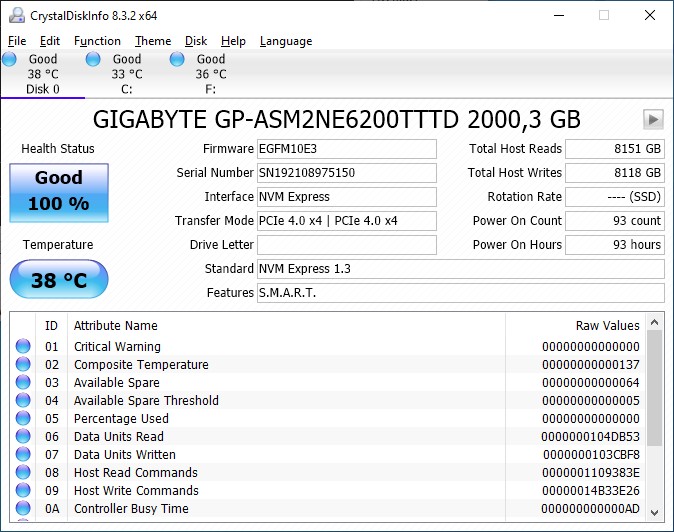
Protracted intense loads are a good opportunity to evaluate the temperature regimes of the drive. On an open stand at rest, the SSD warmed up to 36-38C.
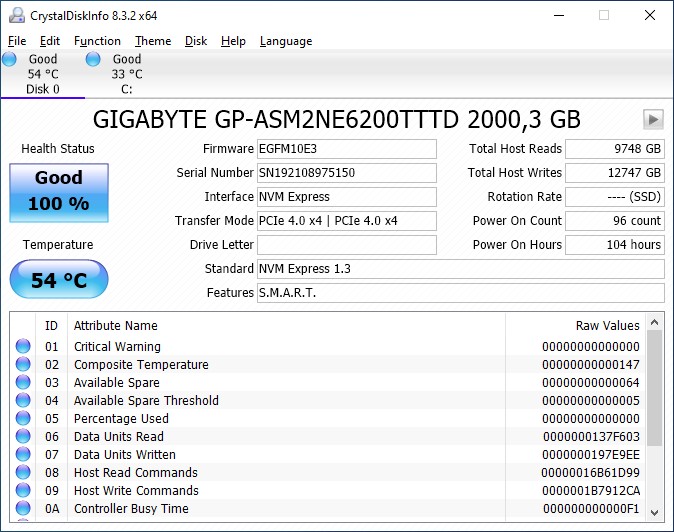
During sequential recording, the temperature of the controller increased to 55-56C. At least, we got such values with the help of service utilities (Crystal Disk Info and HWInfo64). At the same time, similar readings were recorded by an external temperature sensor mounted on the surface of the radiator, so the actual temperature of the controller should have been higher.
A massive radiator block is not superfluous here. The copper cooler definitely improves the thermal performance of the SSD.

The first performance measurements in the new version of the Crystal Disk Mark 7.0.0 utility allow you to get the actual declared parameters. Read speed – up to 5000 MB / s, write – up to 4250 MB / s. However, such indicators are achieved with a QD = 8 request queue, while under Q1T1 conditions, the read speed is significantly lower – about 3000 MB / s, while the write speed, according to CDM readings, is maintained. One way or another, we have visual confirmation that the SSD goes beyond PCI-E 3.0 x4. In this case, the interface does not limit the capabilities of the drive. Although here we are talking only about successive transfers.
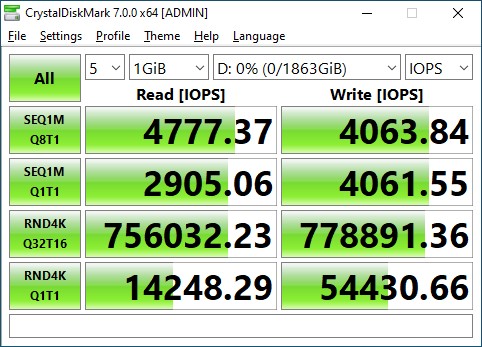
If we present the results in the format of displaying the number of I / O operations, then again we get quite convincing indicators. With Q32T16, we even have slightly higher than the declared values – ~ 750,000 IOPS.
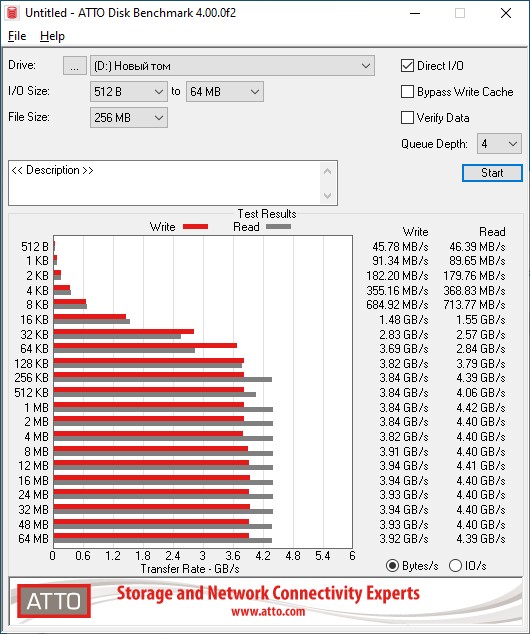
The ATTO test utility in default mode (QD4) registers a peak of 4.4 GB / s when reading large blocks and up to 3.95 GB / s when writing.

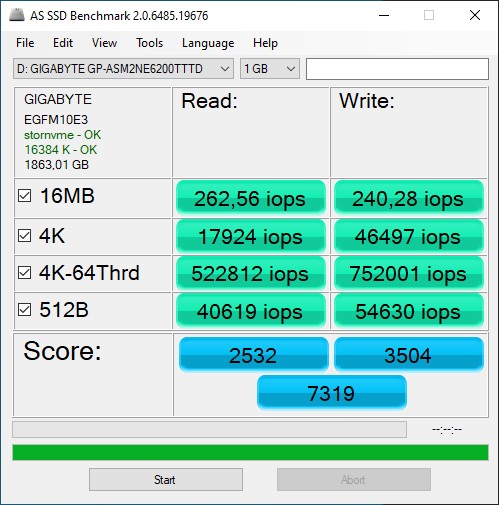
AS SSD is somewhat more modest in assessing the capabilities of the drive, but here the performance of the AORUS NVME Gen4 SSD 2 TB is quite good. Sequential write 4200/3800 MB/s. The results of working with small blocks seem suspiciously high, especially on read operations. It can be assumed that there is some firmware optimization for typical test scenarios.
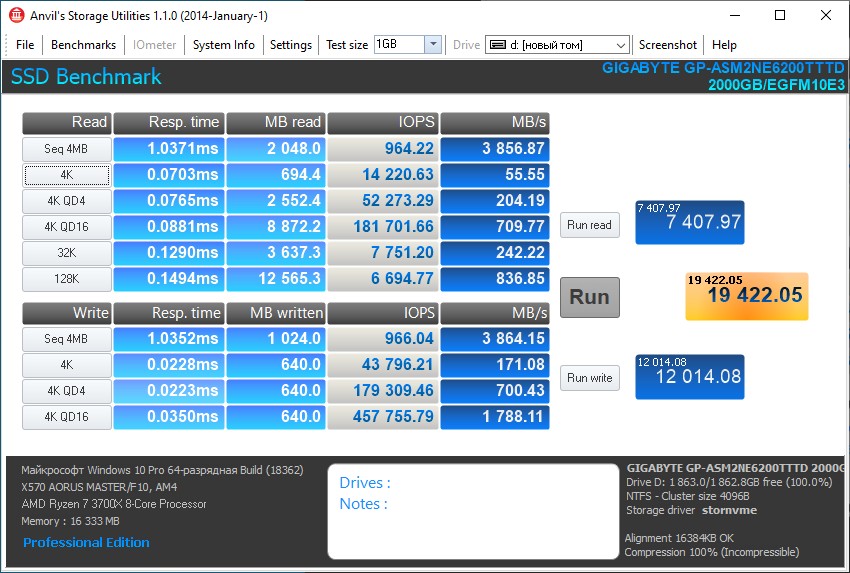
In the test utility Anvil’s Storage, the drive scores about 19,500 points. Although, due to the maximum queue depth of QD16, the SSD does not reach the declared performance in working with 4K blocks, relatively high linear transfers clearly affect the final result.
We also decided to test the capabilities of the AORUS NVME Gen4 SSD 2TB using the PCI Express 3.0 bus. After all, it is in such conditions that the drive will work in all cases, with the exception of variants with AMD X570/TRX40.
For this, the same AMD test platform was used, but the data transfer interface was limited to PCI-E 3.0 mode.
All test utilities register a decrease in linear transfers. Instead of 5000 MB / s for reading, we have 3500 MB / s and the write speed is at the same level. At the same time, the speed of working with small blocks has not changed much. For these tasks, PCI-E 3.0 resources are enough.
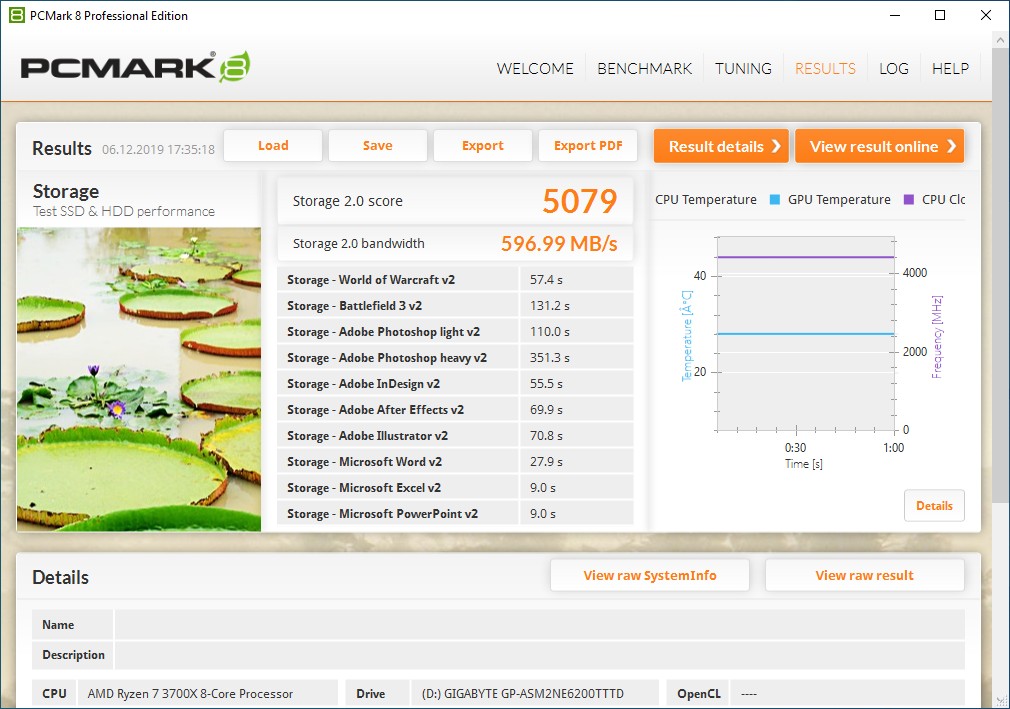
We also tested the drive in the PCMark 8 test suite, which creates a load that is typical for real-world applications. The average throughput of 597 MB/s is a good result for fast M.2 PCI-E drives, but there are no revelations here either. A decent figure, but we are not talking about any records. Similar results are available for models with PCI-E 3.0 interface. Moreover, for comparison, we used the data available to us from devices of a smaller capacity. At the same time, the test does not contain indicators of one of the best Samsung 970 EVO Plus in the class, which noticeably improved in this discipline compared to the regular version.
In real tasks, the data transfer interface is not yet a limiter. With the transfer of AORUS NVMe PCIe4 SSD to PCI Express 3.0, its integral results have not actually changed. The resulting scatter of indicators remains within the measurement error.
External interface speed is important, but even more important to the overall performance of an SSD are the actual capabilities of the controller and flash memory chips, as well as firmware optimization. Therefore, the very fact of switching to PCI Express 4.0 is an important, but not sufficient condition for a significant acceleration of drives.
Will higher performance controllers with PCI Express 4.0 support appear soon? The niche is potentially promising and, for sure, other manufacturers already have some developments in this direction. However, there will definitely not be a rush here. There is no need to talk about the widespread use of platforms with PCI-E 4.0 yet. Many companies are still targeting mainstream Intel platforms, and those with PCI Express 4.0 support are not expected until at least 2021.
However, the market will continue to expand until then. At the very least, AMD should soon offer chipset(s) for more affordable Socket AM4 motherboards that will also get PCI Express 4.0 support.
Price
The AORUS NVME Gen4 SSD line is available now. The older model with a capacity of 2 TB costs ~11,300 UAH. ($475), 1TB version – UAH 6800. ($285), and a 500 GB SSD costs UAH 3,500. ($147). The market also presents models identical in platform ADATA XPG Gammix S50 and Corsair Force MP600. The cost of such options is also close and in general it is noticeably higher than the prices of popular M.2 PCI-E 3.0 models.
With 2 TB drives, everything is difficult, because the range of such devices on our market is still modest, but if you look at 1 TB and 500 GB SSDs, then the choice of much more affordable drives is very wide. For better competition, manufacturers should reduce the price of these devices so that the increase in cost is proportional to the increase in performance of drives in real tasks, and not synthetic benchmarks.




